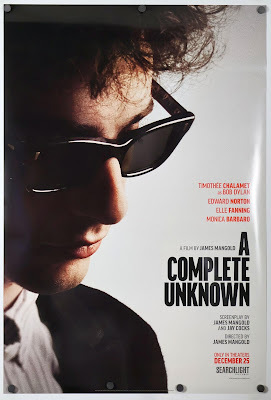“A Complete Unknown”: Bob Dylan Finds (and roars away from) Fame

Watching the Bob Dylanbiopic, A Complete Unknown, was like returning (yikes!) to my collegeyears. Though never a hardcore Dylan fan, I attended a Hollywood Bowl concertthat took place soon after Dylan shocked his fans at the 1965 Newport FolkFestival by playing a plugged-in electric set with members of the PaulButterfield Blues Band. As at Newport, there was booing at the Bowl, withaudience members showing their fury that a man they saw as an earnest youngfolkie (a poet and an one-man band, in Paul Simon’s terms) was turning towardrock-and-roll.
Back then, as an atypicalSixties kid more interested in literature than protest, I didn’t quite see whatthe fuss was about. But in watching A Complete Unknown I was surprisedhow much I responded to those oh-so-familiar tunes: the wistful “Blowin’ in theWind,” the ominous “A Hard Rain's a-Gonna Fall,” thejaunty "Subterranean Homesick Blues." And Irealized, via the film, how much Dylan—a man who liked to beinscrutable—revealed about himself in his songs.
It was smart of thefilmmakers to focus on the very young Dylan, arriving in New York’s GreenwichVillage in 1961 but then—feeling the burden of fame—lighting out for theterritory in 1965. In Timothée Chalamet’s sensitive portrayal we see how muchhe owes to the friends he made along the way, but also how badly he wanted tocut ties that were all too binding.
According to the film, perhaps the mostimportant relationship he built was that with Pete Seeger, played by anexcellent Edward Norton. They meet in the dismal hospital room where Pete iswatching over the dying Woody Guthrie, a longtime Dylan hero. From the first,the two veteran folksingers are impressed by Dylan’s original ballads, and seehim as the potential messiah who can bring young people into the folk musicscene, with its emphasis on social awareness and the beauty of the acousticguitar. Having survived two Dune films, Chalamet is clearly used toplaying messiahs-in-the-making, but the point of A Complete Unknown isthat he doesn’t want to be one.
Nor does he want to be partof a permanent romantic couple. This lesson is ultimately learned by the womenin his life. Elle Fanning’s Sylvie Russo (a re-naming at Dylan’s own request ofthe real-life Suze Rotolo) introduces him to social action, but is unable topenetrate his self-imposed inscrutability. Joan Baez, beautifully portrayed byMonica Barbaro, partners him on the stage and sometimes in bed, but can’t gethim to play nice while on tour and refuses to be merely his occasional sexual conquest.
Which brings me to the Dylansongs that explain it all. “It Ain’t Me, Babe” (a duet by Dylan and Baez in thefilm, while a stricken Sylvie looks on from the wings) makes clear he rejects anylong-term romantic connection: “It ain’t me you’re looking for.” The lyrics of “Don't Think Twice, It's AllRight” seem to justify an itch to cut ties and hit the road. Most apt of all isthe tune whose lyric gives the film its title. “Like a Rolling Stone” is thesong of a loner “with no direction home,” one who is ultimately heading out onhis motorcycle to points unknown. But perhaps the lyric that stays with me mostis Guthrie’s own ditty as sung by Pete Seeger, depicted here as the gentleMister Rogers of the folk music scene: “So long, it’s been good to know yuh . .. I’ve got to be driftin’ along.”
Beverly in Movieland
- Beverly Gray's profile
- 10 followers



